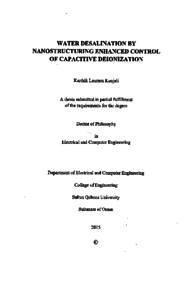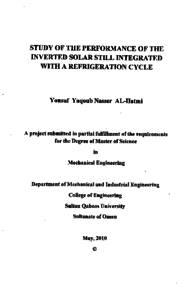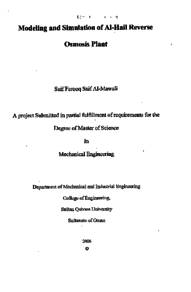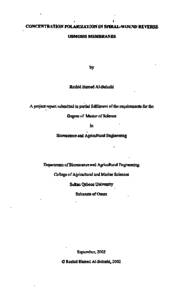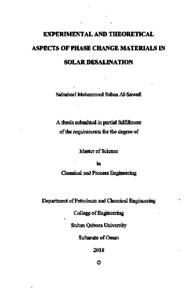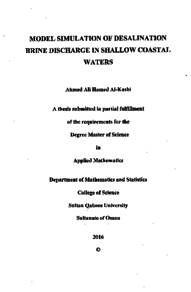Document
Water desalination by nanostructuring enhanced control of capacitive deionization
Publisher
Sultan Qaboos University
Gregorian
2015
Language
English
Subject
English abstract
Water is an essential commodity which has gained significant importance in recent times. Reduction in the available fresh water supply has led to a number of countries adopting desalination of sea water to supplement their water requirements. In water stressed regions like the Middle East, reverse osmosis and distillation processes remain the dominant desalting processes. The technologies however are inadequate for salt removal from remote, low volume and low salinity brackish water sources, where power consumption, portability and operational feasibility are the primary challenges. New technologies like capacitive deionization (CDI) which require low power are portable and focus on potential induced removal of ions from water can circumvent some of the issues, making it a viable alternative for brackish water desalination. However, there is considerable incoherency on the dependence of and relationship between the fundamental parameters governing the salt adsorption capacity of a CDI cell. The investigation of these dependencies forms the basis of this work.
This thesis explores the use of porous activated carbon cloth (ACC) as electrodes within a CDI device for brackish water desalination, with focus on parametric dependence and optimization to help improve the ion adsorption process at the electrode surfaces. The effect of salt concentration, temperature and water flow on the salt adsorption trend was analyzed and a simple mathematical model to effectively predict the desalting capacity of a CDI cell was developed. The research also explored the effect of coating the ACC electrodes with nanostructures of dielectric oxides on the salt adsorption capacity (capacitance) and power consumption of the CDI device. Using theoretical and practical models, it was observed that long nanorod morphologies of low dielectric materials are optimum to improve salt adsorption capacities by almost 50%. The effect of electrode configuration and placement within a CDI cell was also probed where it was observed that potential polarity leads to preferential ion removal. The results were used to develop a unique three electrode CDI cell configuration which symmetrically improved the energy distribution within the cell, leading to further enhancement in the salt removal efficiencies. Finally, a large prototype of the CDI unit was developed and tested for its ability to desalinate ground water from wells along the Al Musanaah coast, wherein it was shown that along with salt removal, the CDI technology is also capable of removing harmful microbes from the water.
Member of
Resource URL
Arabic abstract
الماء هو سلعة اساسية التي اكتسبت أهمية كبيرة في الآونة الأخيرة. وقد إعترفت الجمعية العامة للأمم المتحدة صراحة عن أهمية المياه النظيفة والصرف الصحي لأعمال حقوق الإنسان، مما يحتم على توفير مياه شرب نظيفة ومتاحة وميسرة للجميع. في المناطق المجهدة مائيا مثل الشرق الأوسط التي تعتمد على تحلية مياه البحر الإستكمال المطالب المتزايدة للمياه، لاتزال عمليات التناضح العكسي والتقطير من الأساليب السائدة لتحلية مياه البحر. ومع ذلك هذه التقنيات غير كافية لإزالة الملح من الأماكن صعبة الوصول والبعيدة، إنخفاض حجم مصادر المياه المالحة، حيث إستهلاك الطاقة وقابلية الحمل والتنفيذ هي التحديات الرئيسية. التقنيات الجديدة مثل إزالة الأيونات السعوي (CDI النييتطلب طاقة منخفضة هي محمولة وتركز على حث جهد إزالة الأيونات من المياه تستطيع إبطال بعض المشاكل، مما يجعلها بديلا عمليا لتحلية المياه المالحة
المال
هذه الرسالة تستكشف إستخدام قطعة قماش مسامي الكربون (ACC) كأقطاب داخل جهاز (CDI) لتحلية المياة المالحة، مع التركيز على المبادئ والثوابت الأساسية التي تتحكم بعملية إمتصاص الأيون على أسطح القطب. تم تحليل تاثير تركيز الملح، درجة الحرارة وتدفق المياه على إتجاه إمتصاص الملح وتم تطوير نموذج رياضي بسيط لتنبؤ بشكل فعال عن قدرة التحلية التي تعطيها خلية ال(CDI). كما إستكشف البحث تأثير طلاء أقطاب ال(ACC) بأكاسيد النانو العازلة كهربائيا على قدرة إمتصاص الملح (السعة) وإستهلاك الطاقة للجهاز (CDI). كان يعمل النهج النظري والعملي لتحسين عوامل الطلاء مثل السمك والكثافة الخ. لأقصي سعة قطب كهربائي. إضافة إلى ذلك، تمت دراسة تأثير تكوين الأقطاب ووضعها في خلية (CDI) لتطوير التكوين الفريد التي طورت توزيع الطاقة بشكل متناظر داخل الخلية، مما أدى إلى تعزيز الكفاءة في إزالة الملح، وأخيرا، تم تطوير نموذج أولي كبير لوحدة ال(CDI) وإختبار قدرته لتحلية المياه الجوفية من الآبار على طول ساحل المصنعة حيث أنه قد تبين جنبا إلى جنب مع ازالة الملح، تقنية ال(CDI) هي أيضا قادرة على إزالة المايكروبات الضارة من المياه.
المال
هذه الرسالة تستكشف إستخدام قطعة قماش مسامي الكربون (ACC) كأقطاب داخل جهاز (CDI) لتحلية المياة المالحة، مع التركيز على المبادئ والثوابت الأساسية التي تتحكم بعملية إمتصاص الأيون على أسطح القطب. تم تحليل تاثير تركيز الملح، درجة الحرارة وتدفق المياه على إتجاه إمتصاص الملح وتم تطوير نموذج رياضي بسيط لتنبؤ بشكل فعال عن قدرة التحلية التي تعطيها خلية ال(CDI). كما إستكشف البحث تأثير طلاء أقطاب ال(ACC) بأكاسيد النانو العازلة كهربائيا على قدرة إمتصاص الملح (السعة) وإستهلاك الطاقة للجهاز (CDI). كان يعمل النهج النظري والعملي لتحسين عوامل الطلاء مثل السمك والكثافة الخ. لأقصي سعة قطب كهربائي. إضافة إلى ذلك، تمت دراسة تأثير تكوين الأقطاب ووضعها في خلية (CDI) لتطوير التكوين الفريد التي طورت توزيع الطاقة بشكل متناظر داخل الخلية، مما أدى إلى تعزيز الكفاءة في إزالة الملح، وأخيرا، تم تطوير نموذج أولي كبير لوحدة ال(CDI) وإختبار قدرته لتحلية المياه الجوفية من الآبار على طول ساحل المصنعة حيث أنه قد تبين جنبا إلى جنب مع ازالة الملح، تقنية ال(CDI) هي أيضا قادرة على إزالة المايكروبات الضارة من المياه.
Category
Theses and Dissertations

